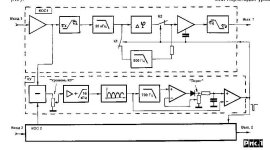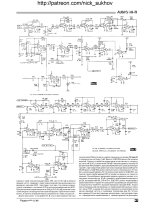I can only agree with you in this respect (and context).because deep scratches on a gramophone record are very annoying to everyone, especially listeners of incorrectly designed phono preamplifiers.
But we are no longer talking about modern turntables, tonearms, cartridges and amplifying and equalizing electronics alone.
Rather about the restoration of completely destroyed records or tapes. Old Enrico Caruso recordings, for example. Shellac, in other words.
We (others) are all only talking about +/- 45° stereo side lettering here. The microgroove.
Incidentally, cutters such as Mr. Pauler, for example, are supposed to use a third-order low-pass filter to limit the bandwidth before the cutting process (in principle). This means that there is no significant information above 20kHz on the vinyl.
Your permanent YT example of a German dancefloor band shows something completely different. I think you should know that. But please let's not argue about it, arguing is not helpful.
And an optical, microscopic metrological analysis of the record in question would reveal the truth.
Best regards,
HBt.
The RIAA EQ spec was very well thought through, so indeed all these potential issues were considered and the result, in a well designed system, is most of these events can be handled gracefully along with a good reduction in amplifier thermal noise.fancy
peak velocity at 6k32Hz with 80cm/sec
This immediately results in a peak deflection of 2µm.
Even with very sensitive MM systems, this is not a real problem. Our grandfathers did their homework and found technical and physical solutions.
I am enclosing an pdf article from the Radiohobby magazine, I was the editor-in-chief at that time, which describes an analog gramophone click suppressor developed at the Kiev Research Institute of Electromechanical Devices by my friends at the request of the USSR audio archives. Fig. 1 is a block diagram of the device, Fig. 2 shows a diagram of the control channel, and Fig. 3 shows a signal processing channel. The operating principle = allocation by the control channel of the action time of the scratch pulse with "intelligent" interruption of the passage of the audio signal in the signal processing channel for this time by an improved sample-and-hold cascade on the VT2 field-effect transistor.Could we please discuss this exciting topic in full in another thread - and especially in English. Thank you in advance.
Attachments
"in well designed system"The RIAA EQ spec was very well thought through, so indeed all these potential issues were considered and the result, in a well designed system, is most of these events can be handled gracefully along with a good reduction in amplifier thermal noise.
Then there is only the question of the insufficiently designed circuits. After the representatives that do not behave correctly. Each of us (here) discussants is immediately able to implement a perfect equalization preamplifier. As far as I'm concerned, we can put this issue to bed.
(...) at that time, which describes an analog gramophone click suppressor developed at the Kiev Research Institute of Electromechanical Devices by my friends at the request of the USSR audio archives. Fig. 1 is a block diagram of the device, Fig. 2 shows a diagram of the control channel, and Fig. 3 shows a signal processing channel. The operating principle = allocation by the control channel of the action time of the scratch pulse with "intelligent" interruption of the passage of the audio signal in the signal processing channel for this time by an improved sample-and-hold cascade on the VT2 field-effect transistor.
And your video impressively demonstrates how effective this (relatively simple) circuit (technology) is. Great. And your video impressively demonstrates how effective this (relatively simple) circuit is. Great. Dear Nick, please continue your work with great former colleagues and don't let yourselves be put off.
HBt.
Nick,I am enclosing an pdf article from the Radiohobby magazine, I was the editor-in-chief at that time, which describes an analog gramophone click suppressor developed at the Kiev Research Institute of Electromechanical Devices by my friends at the request of the USSR audio archives. Fig. 1 is a block diagram of the device, Fig. 2 shows a diagram of the control channel, and Fig. 3 shows a signal processing channel. The operating principle = allocation by the control channel of the action time of the scratch pulse with "intelligent" interruption of the passage of the audio signal in the signal processing channel for this time by an improved sample-and-hold cascade on the VT2 field-effect transistor.
Since you where editor-in-chief at the time of publishing, so you may also be able to give us the text as a word file.
That way we can use Google translate which cannot be done on a .pdf.
Hans
I am enclosing an pdf article from the Radiohobby magazine, I was the editor-in-chief at that time, which describes an analog gramophone click suppressor developed at the Kiev Research Institute of Electromechanical Devices by my friends at the request of the USSR audio archives. Fig. 1 is a block diagram of the device, Fig. 2 shows a diagram of the control channel, and Fig. 3 shows a signal processing channel. The operating principle = allocation by the control channel of the action time of the scratch pulse with "intelligent" interruption of the passage of the audio signal in the signal processing channel for this time by an improved sample-and-hold cascade on the VT2 field-effect transistor.
I remember similar circuits published several decades ago. But .....
do you find the circuit here above practical? (Risunok #3, 10 opamps in the signal path, filters, phase circuits and controlled gain or S/H) - I do not. I would say that doing the job in digital domain is much more effective and with much better results. And, as said several times, a competent preamp design does not have issues with vinyl glitches.
Last edited:
Hi to all in this thread,
I read it and one question is coming back about reproduction, not digitalizing old LP's:
If there is hard pop or click on vinyl record, this is nasty enough on its own, is it really bad if preamp clips too in such event?
My thinking is if we reduce gain of front end to allow no clipping for pops and clicks of bad LP, we also reduce S/N ratio for good records. Is this good compromise?
I read it and one question is coming back about reproduction, not digitalizing old LP's:
If there is hard pop or click on vinyl record, this is nasty enough on its own, is it really bad if preamp clips too in such event?
My thinking is if we reduce gain of front end to allow no clipping for pops and clicks of bad LP, we also reduce S/N ratio for good records. Is this good compromise?
The problem with clipping a capacitor-coupled amplifier is that the bias can shift, possibly by enough to cause a drop-out until the capacitors have recovered.
Good phono preamps have >20dB of headroom so that they will never clip. Great ones don't use capacitor coupling. Having enough headroom and S/N at the same time should not be problematic.
Ed
Good phono preamps have >20dB of headroom so that they will never clip. Great ones don't use capacitor coupling. Having enough headroom and S/N at the same time should not be problematic.
Ed
The 20dB headroom should be at all nodes, before and after the RIAA EQ. A direct-coupled pre-amp needs to be designed as a DC amplifier (with DC feedback). A competently-designed pre-amp should not have difficulty.
Ed
Ed
I haven’t read anyone mentioning this, but pops or clicks transduced by a MM cart, like the one that Bob showed in #8, will be filtered by the combination of Lcart and R-C termination, just before entering the preamp.
An MC cart having a very much lower Lcart won’t have this “pre filter”.
Pops ans clicks can therefore be expected to be more malignant.
Hans
An MC cart having a very much lower Lcart won’t have this “pre filter”.
Pops ans clicks can therefore be expected to be more malignant.
Hans
If you have 30 dB overload capability, cap coupling will never be a problem.
It would be a good idea to come up with a click signal in LTspice and then do a transient analysis (I am on the road until next Tuesday so unfortunately cannot look at it until then).
I suspect there will be some frequency above which any click components won’t cause overload due to the integrating nature of the EQ. (I’m talking here about real world signals). What would be interesting would be to get a handle on those frequency components that are problematic. My wild guess is is it would be between 1kHz to say 5 or 6 kHz, assuming these is little or no click energy below this. Again, a wild guess and I’m certainly open to correction.
I suspect there will be some frequency above which any click components won’t cause overload due to the integrating nature of the EQ. (I’m talking here about real world signals). What would be interesting would be to get a handle on those frequency components that are problematic. My wild guess is is it would be between 1kHz to say 5 or 6 kHz, assuming these is little or no click energy below this. Again, a wild guess and I’m certainly open to correction.
There are some waveforms on this site
https://www.wavecor.co.uk/samples.html
Rough guess: click base frequency sits at 1-2 kHz and at say 10-12 dB greater than the nominal signal level. This can be replicated with a 1ms square pulse at 15mV assuming a nominal input of 5mV at 1kHz.
https://www.wavecor.co.uk/samples.html
Rough guess: click base frequency sits at 1-2 kHz and at say 10-12 dB greater than the nominal signal level. This can be replicated with a 1ms square pulse at 15mV assuming a nominal input of 5mV at 1kHz.
Last edited:
Now I'm trying again to grasp purpose of discussion, few scenarios for LP is in mind:
1. Hi End TT and preamp = one listens to new and pristine LP-s and enjoys , no horrible clicks
2. rare, valuable (and damaged) records = one records raw (on same best available TT) and digitally removes imperfections, saves .wav
3. fun music from used records (from flee market and such) one uses cheapest TT and plays fun party with all clicks incorporated into fun.
Did I miss scenario?
1. Hi End TT and preamp = one listens to new and pristine LP-s and enjoys , no horrible clicks
2. rare, valuable (and damaged) records = one records raw (on same best available TT) and digitally removes imperfections, saves .wav
3. fun music from used records (from flee market and such) one uses cheapest TT and plays fun party with all clicks incorporated into fun.
Did I miss scenario?
Yes, I am pleased to hand you the fileSince you where editor-in-chief at the time of publishing, so you may also be able to give us the text as a word file.
That way we can use Google translate which cannot be done on a .pdf.
Attachments
a few years ago I already compared the possibilities of eliminating clicks with digital means (Adobe Audition and iZotope RX), which turned out to be much worse than this purely analog device. Compare for yourselfI would say that doing the job in digital domain is much more effective and with much better results.
- Home
- Source & Line
- Analogue Source
- RIAA Overload Performance’ to Encoded Signals (i.e. the Music) and Response to Clicks and Pops (Unencoded)

